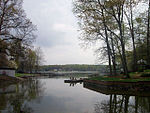Bringle Ferry Bridge
Buildings and structures in Davidson County, North CarolinaBuildings and structures in Rowan County, North CarolinaNorth Carolina building and structure stubsNorth Carolina transportation stubsRoad bridges in North Carolina ... and 3 more
Southern United States bridge (structure) stubsTransportation in Davidson County, North CarolinaTransportation in Rowan County, North Carolina
The Bringle Ferry Bridge is a crossing of the Yadkin River Channel and the Tuckertown Reservoir in Rowan County, North Carolina and Davidson County, North Carolina. The bridge is on Bringle Ferry Road between Salisbury, North Carolina and Denton, North Carolina. It is the only crossing of the Yadkin River between the Interstate 85 bridge at Spencer, North Carolina and the NC Hwy 49 bridge near Richfield, North Carolina. The Bringle Ferry Bridge has views of the High Rock Dam to the north, which separates Tuckertown Reservoir from High Rock Lake.
Excerpt from the Wikipedia article Bringle Ferry Bridge (License: CC BY-SA 3.0, Authors).Bringle Ferry Bridge
Bringle Ferry Road,
Geographical coordinates (GPS) Address External links Nearby Places Show on map
Geographical coordinates (GPS)
| Latitude | Longitude |
|---|---|
| N 35.596666666667 ° | E -80.231666666667 ° |
Address
Bringle Ferry Bridge
Bringle Ferry Road
North Carolina, United States
Open on Google Maps





